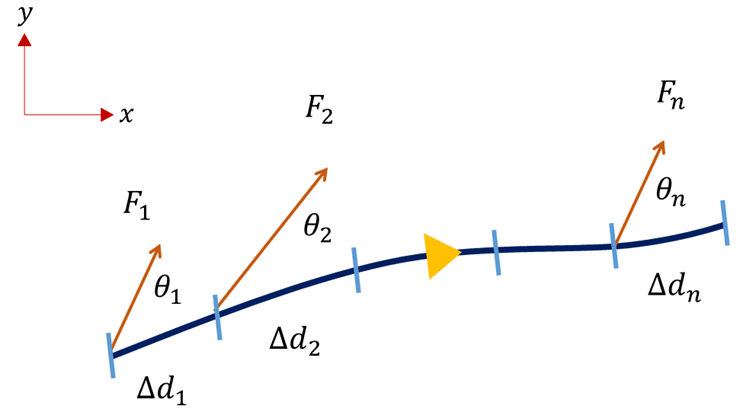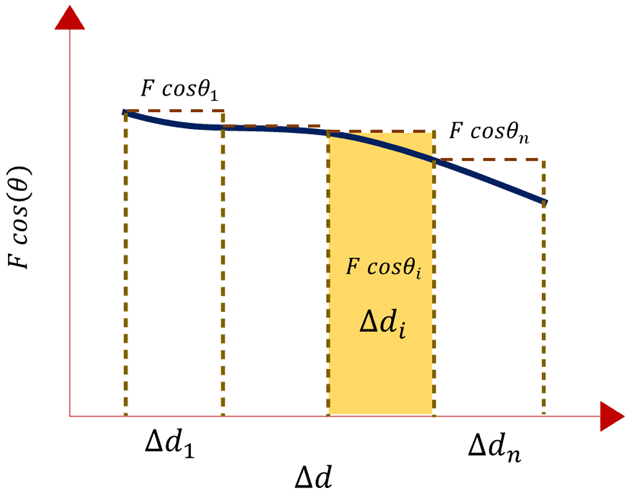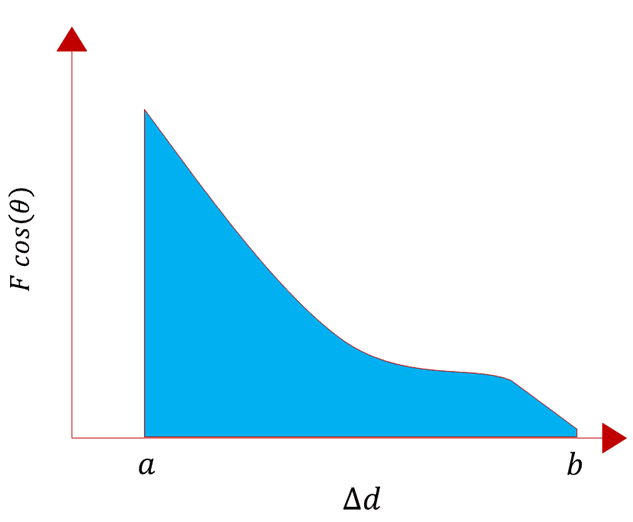Real-world examples in physics and engineering often involve variable forces, requiring precise calculations of work done. For this, work done by a variable force is determined using summation and integration methods.
Table of Contents
Introduction
We know that what it means by work done by a constant force in physics. Now is the time to understand whether in the real world the work done remain the same irrespective of the force acting on it? Or do we use the average force to find the work done? The answer to these questions lie in the concept of variable force.
Variable Force
In many real-world scenarios, the force acting on an object does not remain constant throughout its motion. Such forces are known as variable forces.
These forces require a more detailed approach to calculate the work they perform.
Examples of Variable Forces
- Gravity
The force of gravity acting on a rocket decreases as it moves farther away from Earth, following an inverse square relationship with the distance from the centre of Earth.
- Springs
The force exerted by a spring increases as it is stretched beyond elastic limit, according to Hooke’s Law, ![]() , where
, where ![]() is the spring constant and
is the spring constant and ![]() is the displacement from equilibrium.
is the displacement from equilibrium.
These examples highlight situations where forces change depending on position or distance, making it necessary to calculate work in a step-by-step manner.
Derivation of Work Done by a Variable Force
To calculate the work done by a variable force, divide the motion into small intervals, in such a way the force can be approximated as constant.

1. Divide the Path
Consider a particle moving from point ‘a’ to point ‘b’ along a curved path in the xy–plane, and the curved path is divided into small equal intervals as shown.

2. Approximate Force and Displacement
The force acting along each path is constant, i.e.,
![]()
The corresponding path is also divided into small intervals of displacement, i.e.,
![]()
3. Work Done in Each Interval
We know that the work done is calculated as follows,
![]()
Here, ![]() represent the work done by the force.
represent the work done by the force.
For 1st Interval
![]()
For 2nd Interval
![]()
For nth Interval
![]()
4. Total Work Done
The total work done is the sum of the work in all intervals, given as,
![]()
![]()
![]()
![]()
Graphical Representation of Work Done by a Variable Force
A graphical method can also be implemented to visualise the work done by a variable force.
Plot ![]() vs. Displacement
vs. Displacement
Consider the graph plotted against the effective component of force ![]() and the displacement
and the displacement ![]() as shown.
as shown.

The path is divided into small intervals, and is assumed constant in each interval.
Area under the Graph Line
Each shaded rectangle in the graph represent the work done in the ![]() interval, and given as,
interval, and given as,
![]()
![]()
![]()
Here,
 = work done in the
= work done in the  interval
interval = area of rectangle in the
= area of rectangle in the  interval
interval
Total Area as Work
The total work done is equal to the sum of the areas of all rectangles.
![]()
![]()
Here, ![]() are area of small rectangles.
are area of small rectangles.
This method provides an intuitive way to understand work as the area under the
curve.
Limit of Small Intervals
Smaller Intervals, Greater Accuracy
As the size of each displacement interval ![]() becomes smaller, the approximation of constant force within each interval becomes more accurate. When
becomes smaller, the approximation of constant force within each interval becomes more accurate. When ![]() approaches zero, the number of intervals increases infinitely.
approaches zero, the number of intervals increases infinitely.
Area under the Curve
In the limit where ![]() approaches zero, the sum of the rectangular areas becomes the exact area under the curve. Mathematically, this is represented by integration. This integral gives the precise value of work done by the variable force over the entire path.
approaches zero, the sum of the rectangular areas becomes the exact area under the curve. Mathematically, this is represented by integration. This integral gives the precise value of work done by the variable force over the entire path.
Conclusion
The work done by a variable force in moving a particle between two points is equal to the area under the ![]() . This idea is fundamental in physics and engineering, providing a way to analyse systems where forces vary with position, such as in gravitational fields, elastic systems, and more.
. This idea is fundamental in physics and engineering, providing a way to analyse systems where forces vary with position, such as in gravitational fields, elastic systems, and more.
Frequently Asked Questions (FAQs)
What is a variable force?
A variable force is a force that changes in magnitude or direction as an object moves, unlike a constant force, which remains unchanged.
Why is work done by a variable force different from a constant force?
In the case of a constant force, work is calculated using a simple formula:
![]()
However, for a variable force, the force changes over distance, requiring summation or integration to determine the total work done.
What are some real-world examples of variable forces?
Examples include:
- Air resistance acting on a moving object
- Gravitational force on a rocket moving away from Earth
- The force exerted by a stretched or compressed spring (Hooke’s Law)
How do we calculate work done by a variable force?
The work done is found by dividing the motion into small intervals where the force is approximately constant. The total work is obtained by summing the work done in each small interval or by integrating the force over the displacement.
What is the significance of the area under the force-displacement curve?
The area under the ![]() vs. displacement graph represents the total work done by the variable force. The smaller the intervals, the more accurate the approximation.
vs. displacement graph represents the total work done by the variable force. The smaller the intervals, the more accurate the approximation.
Why do we use integration in calculating work done by a variable force?
As the number of intervals approaches infinity, the summation of work done in each interval turns into an integral, which provides an exact calculation of the work done.
What is the mathematical expression for work done by a variable force?
The work done is given by:
![]()
Here,
 = force
= force = displacement
= displacement-
 = angle between force and displacement
= angle between force and displacement
How does Hooke’s Law relate to work done by a variable force?
Hooke’s Law states that the force exerted by a spring is proportional to its displacement:
![]()
Since this force varies with displacement, the work done in stretching or compressing a spring requires integration.
What happens when the displacement interval approaches zero?
When the displacement interval becomes infinitely small, the work done is calculated precisely using integration, eliminating approximation errors.
Why is the study of work done by variable forces important in physics and engineering?
Understanding work done by variable forces is crucial in fields like aerospace, mechanical engineering, and biomechanics, where forces change with position, such as in gravitational fields, elasticity, and frictional systems.
